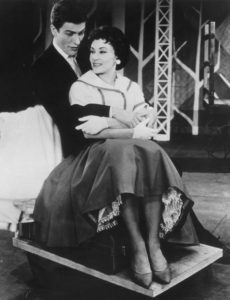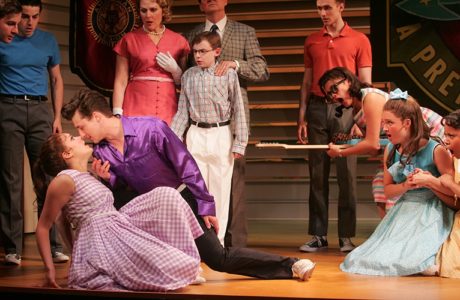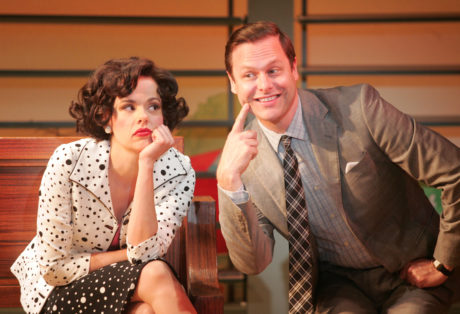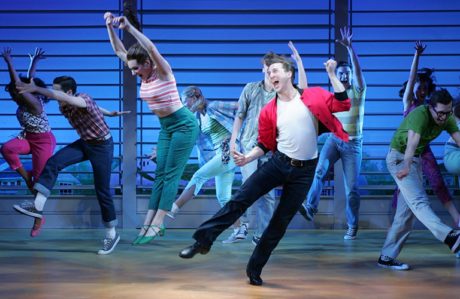I have been viscerally connected to this charming musical about teenage life during the mid-1950s, when pop music was surrendering to the hot wave of rock ‘n roll started more or less by icon of the era, Elvis Presley. He was no new Sinatra, Perry Como, or Andy Williams and new music plus his unique performing style entered virtually every living room via the then smash Sunday night TV variety program, simply called The Ed Sullivan Show.

I mention my connection, because early in the creation of the musical, its producer Edward Padula, approached me as the agent representing Chita Rivera who had had an exciting two year run with West Side Story, in which she lit up the sky on Broadway and in London. In those days, theatre practiced type casting, and Rivera was of Puerto Rican extraction. Leading ladies in musical comedies were all Caucasian unless the role called specifically for someone of color or Spanish, French, or any language other than English.
Barbara Cook (She Loves Me, The Music Man) comes to mind, as does Florence Henderson (Fanny), Julie Andrews (The Boy Friend, My Fair Lady), Gwen Verdon (Sweet Charity, Damn Yankees), Tammy Grimes (The Unsinkable Molly Brown) and many more. Ms. Rivera would never have been offered any of those roles. But adventurous Mr. Padula, recognizing her star quality, decided to change all that, and he asked me if we could discuss the leading role in a new all-American musical he was just beginning to assemble from scratch.
Padula had been a successful stage manager and book director, but he longed to be a producer and after auditioning several young composer-lyricists, he went with Charles Strouse and Lee Adams who, like him, had never had a show on Broadway. He went through a book writer or two, but none came up with an acceptable story line, and finally he went with young Michael Stewart who was getting buzz as a contributor to the successful variety show headed by Sid Caesar.
When the material was finally in presentable shape, it evolved from something called Let’s Go Steady into Bye Bye Birdie, a title that did not attract single investors. But the great thing about Padula and his team is that he and they remained committed to their dream show through the next two years, before it finally could actually go into production in 1960. Before that date could be finalized, a director/ choreographer had to be signed, and again Padula paid attention to his instincts and hired Gower Champion, whose only New York credits were as choreographer for two small revues and a moderately successful book show (Make A Wish). He’d never been in full directorial command, but that didn’t phase the producer.
Here’s where I came in. The show was capitalized at the then standard $300,000, plus a possible 20% overcall, and Ed was having a hard time raising it. I had a personal reason for wanting to help. My cousin Andrew and I decided to raise 10% of that capital by plugging the show to everyone we knew. There must have been 50 live backers’ auditions in the next months, and a Texas oil man L. Slade Brown), stagestruck and eager, came up with half the capital, thus making the production’s schedule realistic. I was further motivated to help, because my own career as a theatrical agent was just beginning to flourish, and I was the proud manager hoping to help turn Ms. Rivera in to a star.
Mr. Champion was not certain. He’d envisioned a young star like Debbie Reynolds or any number of any other current favorites. But Padula was convinced Chita would bring something fresh and exciting to the show. Her would-be director asked if she’d meet with him for tea so he could get to know her better. I accompanied her, and the meeting went very well. He was tactful and said he was sure she’d be curious about him were he being considered as a performer himself, for a role unlike those he’d ever played. He very graciously asked if she’d mind showing him some material that would reveal her vulnerability, and perhaps her sense of humor. He’d loved her work in the West Side musical, but her character in that had none of those qualities.
She asked for a few days to prepare, and on the appointed day I joined her at a Broadway theatre where she wore a simple dress with a Peter Pan collar. After a few nervous “hellos,” she climbed on to the stage, sat on a stool very quietly, then nodded to her accompanist, and in the sweetest most mellow voice imaginable, she sang “Sit there and count your fingers, little girl blue. What else? What else is there to do?”.
As she took a breath to support the next line, Gower Champion rushed down the aisle, and shouted: “That’s it!. It’s yours, you are our Rosie!” I kid you not — two lines and he knew she could play the part; she could probably play little Bo Peep or Lady Macbeth, so instinctively honest was her way with the words. His one concession to her Latino background was that the character Rose Grant became Rose Alvarez, and now all those WASPY ladies would not have been right for it! The film, shot several years later, used Van Dyke, but Janet Leigh played Rose and she was about as Hispanic as Julie Andrews.
You’d have thought I got the part, so thrilled was I. And my joy was doubled when a short time later I accompanied Johnny Carson and Dick Van Dyke, both clients at the agency where I worked, to their auditions for the male lead, and Dick nailed it.
For a young man (me) who had been handling talented supporting players for at least 5 years, this was a breakthrough. If the show was a hit, I would be handling the two stars of a hit Broadway musical. In our profession, that was a big deal.

That’s a long way round to The Goodspeed revival as of this week. The little town of East Haddam, Connecticut has been home to the musical theatre program at this 19th century theatre on the Connecticut River for 53 years ; Michael Gennaro became its artistic director last season, and Birdie is something of which he should be inordinately proud.
I know the show backwards, and I was apprehensive on approaching, but I needn’t have been. He chose Jenn Thompson and Patricia Wilcox to direct and choreograph and the show is better than ever. They’ve even improved certain key moments — the song “Put On A Happy Face” has become a duet for the two leads, instead of the charming Champion version of having the leading man sing it to a down-in-the mouth ensemble player. It’s been expanded as well.

Another marvelous enlargement has turned “A Lot of Livin’ To Do”, started as a solo, turned into a rousing ensemble song and dance that brings energy and great fun to the second act.
“The Telephone Song,” sung in the original production in a giant grid filled with teenagers, Thompson and Wilcox have saved a ton of money by coming up with their own way of earning cheers. From the scenic concept to the ’50s comment on fashion, the show looks brand new.

And the cast! George Merrick, Alex Walton, Janet Dacal. Warren Kelley, Tristen Buettel, and Rhett Guter (a dazzling and original Conrad Birdie), sparkle all the way from the two leads (Rosie Alvarez and Albert Peterson), down to the smallest (Harvey Johnson) in this regional theatre production. With a shorter rehearsal time than Broadway, less money, and the difficulty in finding talents of this caliber to be available for a long season in a tiny town must be enormous. But this bunch all seem delighted to be up there, and I can’t comment strongly enough on how much they deserve to be.
With all respect to Ms. Rivera, Mr. VanDyke, Paul Lynde, Kay Medford, Michael J Pollard, and of course Gower Champion and Edward Padula, all of whom brought the original to vivid life, this vibrant new look at the show revitalizes it, and I certainly hope others are fortunate enough to have a gander for themselves.
Bye Bye Birdie only runs until this Thursday, September 8th, so if you can consider a trip north, I highly recommend you give yourself a treat and see for yourself.
Bye Bye Birdie plays through September 8, 2016 at The Goodspeed – 6 Main Street, in East Haddam, CT. For tickets, call the box office at (860) 873- 8668, or purchase them online.






Yes, it’s all true, and a beautiful time it was.
Charles